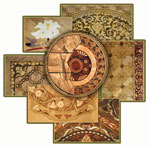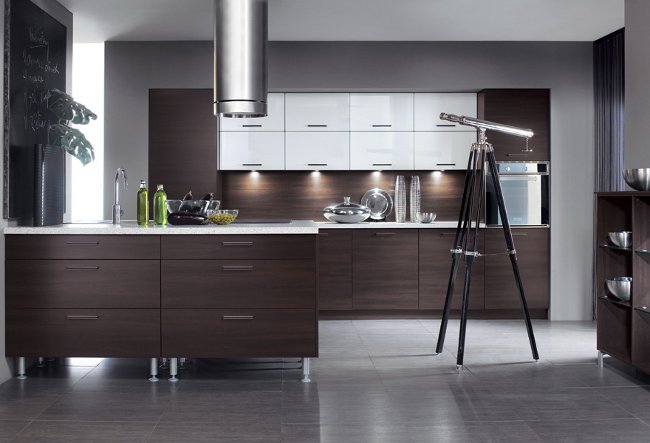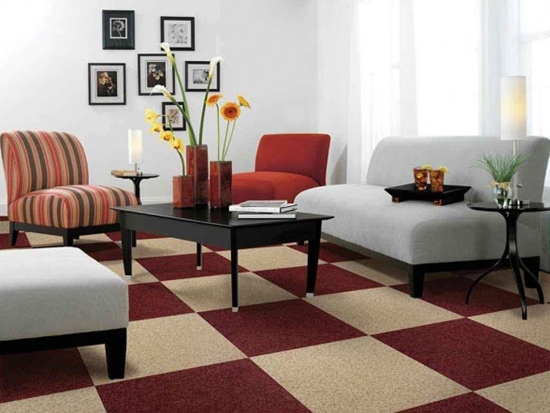Parquet

Parquet - one of the most popular floor coverings. For a long time the parquet was valued very highly, and only very wealthy people could afford the parquet floor. Therefore, at present, this parquet is a symbol of comfort and well-being in the house.
It is customary to call parquet a planed woodyslats of small size, designed for flooring. Different types of wood are used for parquet: traditional (oak, ash, hornbeam, maple, beech, pear, apple), and exotic (rosewood, amaranth, boxwood, thuja, cypress, ebony, sandalwood, ironwood). The color and pattern of the parquet should be selected in accordance with the general interior of the room.
Types of parquet
Distinguish piece, type (mosaic), panel and also massive parquet (massive parquet boards). For artistic parquet is used piece parquet - it allows you to lay out on the floor of the real wooden paintings. Parquet board It differs from the piece parquet with a large size of the slats and is often used for laying the floor in living quarters.
Panel flooring is a two-layer structure consisting of a thick base (shield) and glued on it dies of valuable wood. The shield itself, as a rule, is made of a pine beam.
Shield parquet is most often made in the form ofsquare with a side of 400-600 mm. The face surface of the paneled parquet can be laid out in the form of a pattern of varying complexity: from the standard "Christmas tree" to complex geometric shapes.
Mosaic (composite) parquet used to simplify the procedureartistic laying of parquet. Mosaic parquet - it's factory-made individual modules, which are ready-made elements of the pattern (rosettes, borders). Modules of a mosaic parquet can both be built in piece parquet, and it is used independently - for a set of an art parquet.
In addition to natural parquet, artificial parquet. Laminate (laminated parquet) has a similaritywith a parquet board. It is also a multi-layered structure: a base of pressed wood, a lower moisture-resistant layer and an upper decorative layer imitating a picture of precious wood. The laminate is covered with protective resin.
Parquet laying
Before laying the parquet must pass"Acclimatization", in a room in which the parquet floor will be laid. To do this, the parquet elements in small piles should be decomposed in the room and left for 3-5 days. The temperature in the room should not be less than 18 ° C and more than 23 ° C, relative humidity of air - 45-60%.
Laying parquet can be made glutinous and glueless way. With the adhesive method of parquet dies completelyglued to the base with a special mastic. In the glueless way of laying the parquet, the connection "spike-groove" is used. Such a method does not require the fixation of parquet plates on the base, so this laying is called "floating".
When laying the parquet to the base,strict requirements. The substrate must be perfectly flat and dry (humidity not more than 7%). To lay a piece of parquet on a concrete screed, a layer of waterproofing material is laid, then a mastic is adhered to the base with a moisture resistant plywood and is additionally fixed with screws. On this basis with cold mastic glued parquet.
The parquet board is fixed on special racks -lags. The logs are fixed a short distance apart to ensure the rigidity of the future structure. Parquet boards are fastened to the logs with the help of nails (length 60-70 mm), which must be driven at an angle, into the base of the bottom slot of the groove. The hats of the nails are "drowned" in the thickness of the wood - for this, a doberman is used.
When laying parquet should leave a technological gap of 10-12 mm around the perimeter. At the end of laying, the parquet is sealed around the perimeter of the base with a special sealant.
The finishing of the parquet can only be doneafter complete drying of the mastic (with glue method). Finishing consists of several stages: looping, grinding and varnishing. The varnish is applied in 5-7 layers with the help of rollers, spatulas or spray gun.
At the end of all work on the perimeter of the parquet floor, a plinth is installed.
Operation of parquet
Parquet requires a careful attitude and careful care. After the completion of all parquet work must be at least 14 days - so much time is required for the final hardening of the lacquer. During this time it is extremely undesirable to install furniture indoors and cover the parquet with something.
Walk on the floor can not be earlier than a day after the end of all work. It is best to walk in socks or special "parquet" slippers. In the future, To exclude walking on a parquet floor on "stiletto heels", heels. You can not walk on the parquet floor in dirty street shoes, so before entering the room it is desirable to install a special mat for cleaning shoes.
In order for the parquet to last as long as possible, the room should always keep the optimum temperature (18 ° C - 23 ° C) and humidity (45-60%).
Do not put water on the floor. Under the legs of furniture, standing on the floor, you needto put protective covers from natural materials. To clean the parquet from dirt, use a well-wrung out damp cloth, then wipe the parquet dry. To remove strong contaminants, use special parquet cleansers with a pH of 6-8.














